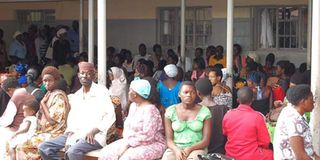Prime
Jinja hospital: A tale of a facility lacking doctors

Patients at Jinja Regional Referral Hospital wait for treatment. Below is a section of the facility’s wards. PHOTOS BY DENIS EDEMA.
What you need to know:
The health institution serves Busoga region but some of its departments are underutilised due to staff shortages leaving many patients unattended to.
Jinja
On the afternoon of Friday August 3, 2012, hundreds of protesters gathered at Jinja Regional Referral Hospital’s theatre following the death of an expectant mother. Shanita Nakato Namubiri died after her operation had reportedly been delayed by a doctor seeking a Shs700,000 bribe from her relatives.
Angry relatives backed up by residents and local politicians faced off with a seemingly impotent riot police.
The police could neither lob teargas canisters at them nor shoot live ammunition while on the precincts of the hospital for fear of disturbing the patients.
Tempers calmed down after the Permanent Secretary in the Ministry of Health, Mr Asuman Lukwago, visited the area and promised an investigation. The findings of the investigation remain unknown and the aggrieved family could have moved on, but that incident remains a major blight on the reputation of a hospital which was started in 1920 to treat and rehabilitate World War 1 veterans.
Most of its buildings were constructed in the 1950s and 1960s, but if the architecture and the appearances of the structures are anything to go by, most of them need renovation while others need to be demolished to pave way for new ones.
Over the years, the hospital has grown to become the largest health facility in eastern Uganda with 11 wards and a private wing, both of which have a bed capacity of 600.
However, the facility sometimes admits more than its capacity compelling some patients to sleep on the floor while infants share beds.
Sights of between three and four children sharing a bed are not strange.
According to the director of the hospital, Dr Michael Osinde, the facility, which was elevated to regional referral status in 1994, has 20 doctors, 16 consultants and 185 nurses serving a population of about five million strewn across Busoga region and parts of neighbouring Buganda.
Dr Osinde says the facility is expected to provide treatment and care for, among others, diabetes, tuberculosis, HIV/Aids and psychiatric problems, but meager resources and manpower shortages make provision of quality service impossible.
For instance, while it has enough drugs to handle psychiatric cases, there are no personnel to handle the huge number of cases. He says the hospital receives a monthly income of Shs50 million, which pays for, among others, compound cleaning and maintenance, communication, transport, stationary and utility bills.
In 2003, the National Advisory Committee on Medical Equipment, headed by Dr E. K. Naddumba released guidelines on standard equipment for health centres, district and regional referral hospitals. However, health workers find the recommendations of the document difficult to implement. While it recommends the installation of a power backup like a standby generator and refrigeration facilities for the mortuary, the hospital lacks the equipment.
The institution has been struggling to fix the morgue’s old dysfunctional refrigerator for the past one year.
Dr Osinde says the hospital lacks a cancer ward, the means to deal with many infectious diseases, has inadequate ambulance services and still lags behind in surgical services. Last year, the government spent Shs218 million on the construction of a structure for a blood bank, but it is yet to become operational.
Blood shortage
“The facility lacks infrastructure to operate at the level of a blood bank. If it had been in place, we would not be facing any shortages,” the hospital’s deputy director, Dr Daniel Balinanseko, says. Dr Osinde says at least five children die due to the blood shortage daily, adding that the casualty ward and maternity ward are also affected.
However, he notes that the biggest challenge is lack of manpower. “We receive more than 1,000 patients per day, but the health workers are few,” he says. This has affected other departments such as the Intensive Care Unit. In July 2009, the 20-bed unit was constructed with funding from the government and the rotary clubs of Jinja and Oregon but it is underutilised.
Its equipment lies idle since there is no specialised staff to operate and maintain it while the Health ministry has never arranged to train personnel in intensive care management. But one question remains; when will this tale end?




